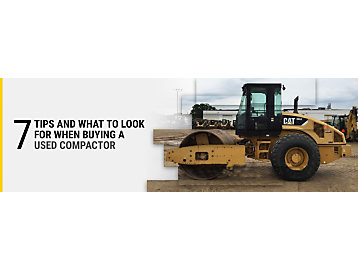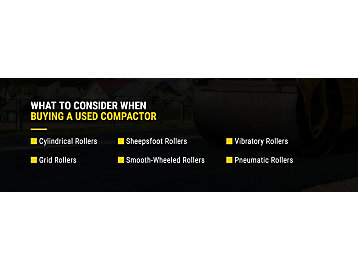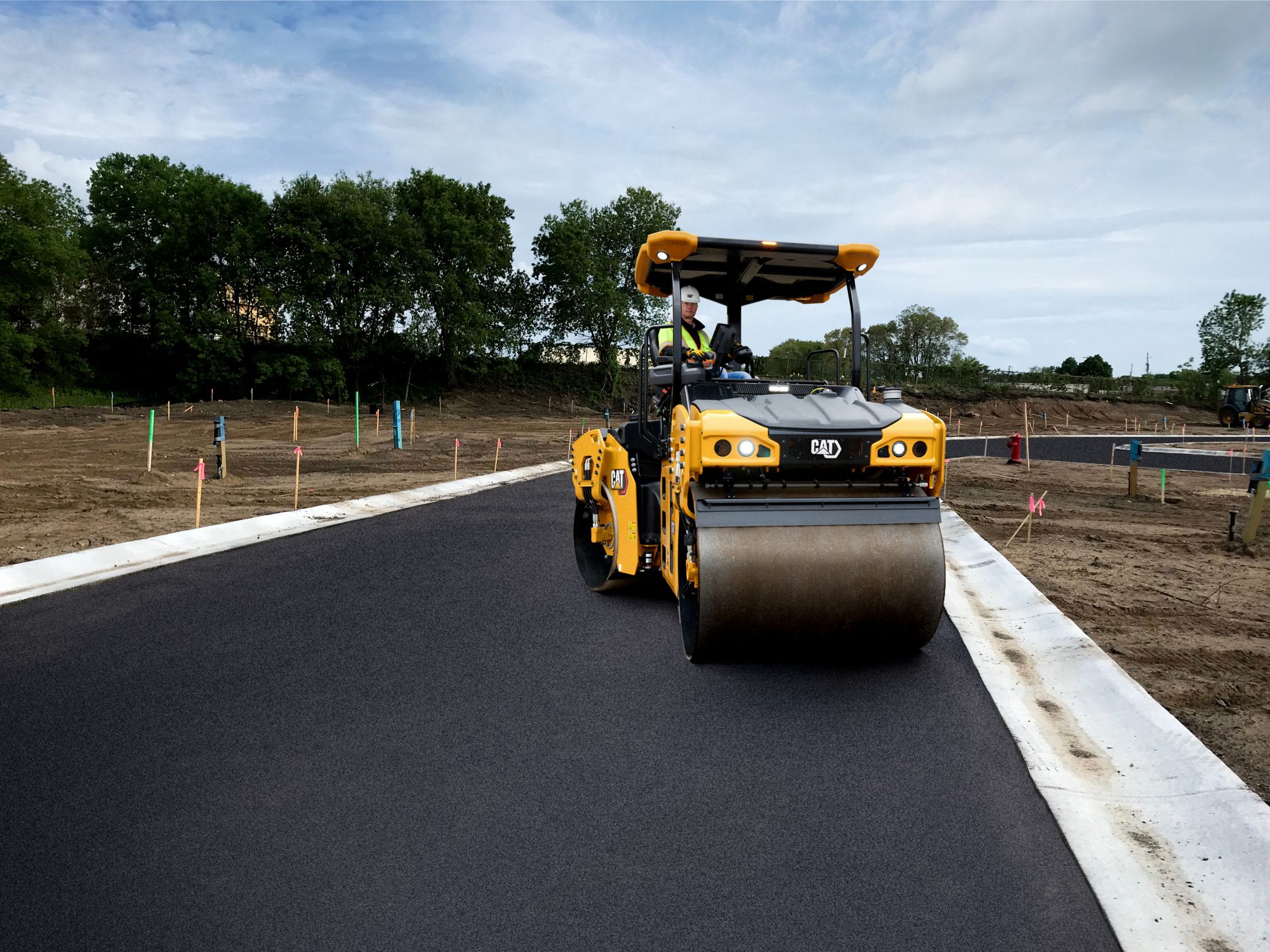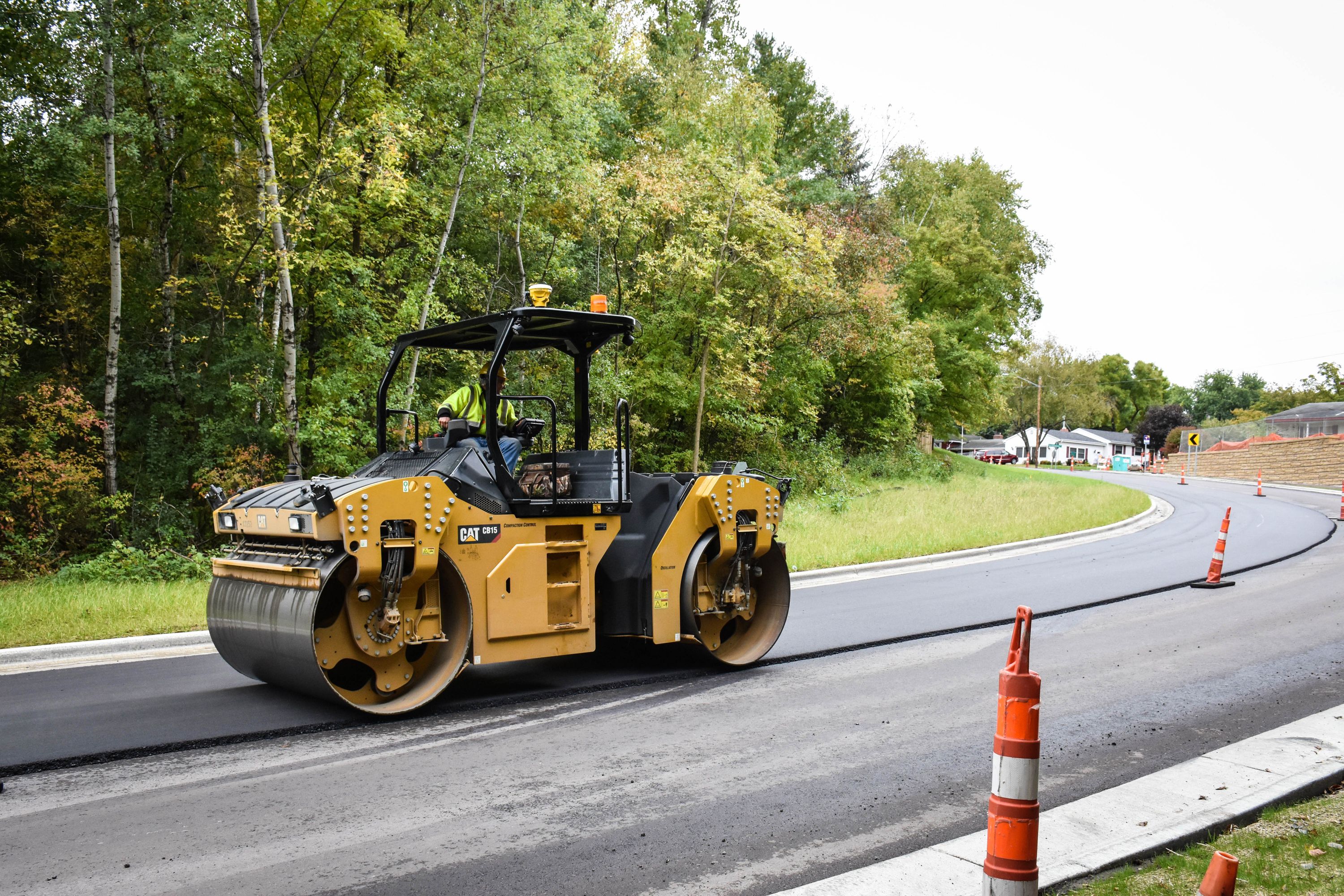

Sign In
Welcome! Sign In to personalize your Cat.com experience
If you already have an existing account with another Cat App, you can use the same account to sign in here
Register Now
One Account. All of Cat.
Your Caterpillar account is the single account you use to log in to select services and applications we offer. Shop for parts and machines online, manage your fleet, go mobile, and more.
Account Information
Site Settings
Security
Author: Small Business Expert | April 1, 2021 | Topic: Used Equipment

When you're looking to expand your fleet for your next paving job, a used compactor can be an excellent option. Many companies rely on used compactors from trusted brands like Caterpillar to deliver high-quality performance at an affordable cost. While there are many advantages to purchasing a used compactor, buyers should also do their due diligence before they make a purchase to ensure the previous owner kept the compactor in good condition.
Below, learn more about what to look for when buying a used compactor, including information about the best inspection tips. You'll also find out more about the benefits of buying a used compactor.
What to Consider When Buying a Used Compactor
Choosing the right used compactor usually comes down to sorting through all the compactor options and selecting the right one for your needs. Different compactors are built for different jobs, so you should be aware of the various options on the market. Check out how to spot the differences between the six main types of compactors below:

1. Cylindrical Rollers
The simplest kind of compactor is a cylindrical roller. These rollers are typically pushed via hand and are relatively lightweight. An operator pushes the roller forward without engine power assisting them. Usually, these rollers are used by individuals for yard work and other personal, smaller projects. Due to their small size, they may be useful in specialized, narrow areas throughout a project.
2. Grid Rollers
Grid rollers are a primary type of compactor used by many professionals in the construction industry. A steel bar network forms a grid-like pattern surrounding the steel drum, which then rolls over the ground. Typically, these rollers are pulled or towed behind a heavy machine, such as a tractor.
The cylinder drum's grid design applies very little kneading action during compaction work. It also produces high contact pressure. These compactors are generally used on weathered rocks, coarse soils and well-graded surfaces during subbase and subgrade road construction.
3. Sheepsfoot Rollers
Sometimes referred to as tamping or padfoot rollers, sheepsfoot rollers have rectangular lugs attached to a cylinder drum. These lugs are also known as feet. Due to the feet's design, operators commonly use sheepsfoot compactors to compact silty clay and soil for road construction applications. You can also find these rollers used with pneumatic rollers, as operators like to use the pneumatic models to complete areas originally compacted by sheepsfoot rollers.
Companies can also adjust compactors to increase their efficiency by adding extra weight to them. Operators will ballast a sheepsfoot drum with mounting steel sections, damp sand or water to increase its weight. This extra weight then leads to a more efficient compacting job.
4. Smooth-Wheeled Rollers
Single- and double-drum rollers are the two main kinds of smooth-wheeled models. A single-drum roller is sometimes called a three-wheeled roller due to its design. These machines have two wheels in the back and a single steel drum in the front. They're one of the most popular forms of rollers, with many professionals taking advantage of their small size to use them in tighter areas. Additionally, they're often used to pave highways and sidewalks and create foundations.
Double-drum rollers feature two steel drums, with one in the front and the other in the rear. These rollers are often used to pave highways, as their two drums efficiently and quickly flatten and pave ground. Typically, operators use double-drum rollers for gradual or flat surfaces like asphalt, as they don't feature much traction.
5. Vibratory Rollers
Vibratory rollers are very similar to smooth-wheeled rollers, but they differ in one key area. Unlike the other type, they feature a specialized vibrating component. While a roller typically flattens a surface during compaction, these vibratory rollers vibrate as well.
This vibratory function is especially helpful for companies preparing land for a structure. Structural damage often occurs when a building sinks or warps due to natural empty spaces in asphalt, concrete and soil. A vibratory roller improves structural integrity by forcing materials into these empty spaces. You'll also often see these rollers compacting materials like gravel or crushed rocks.
6. Pneumatic Rollers
Pneumatic rollers are a type of ride-on roller featuring several rows of rubber tires installed on the rear and front. Compared to other rollers, pneumatic models are quite large and made to cover wide surface areas. A pneumatic roller's rubber tires offer uniform pressure across their width and provide a significantly high coverage area. Companies usually employ this equipment to polish a final product or smooth pavement. Operators also use them to compact cold mixed pavements, loose soil and cold-laid bituminous pavement.
7 Inspection Tips for Used Compactors
Alongside purchasing the right type of compactor, you'll also want to look for signs that a used compactor is in good condition before investing in it. There are a few things to look for when buying a used compactor to ensure it's in good condition and has been well maintained by the previous owner. Being aware of tips for buying a used compactor can help you avoid damaged models and get the most value from the one you purchase.
Below are the top seven used compactor inspection tips:
1. Check the Drum
A compactor's drum or drums is the most important part to check before purchase. If a drum is damaged, your paving ability can be affected. For example, stones and other objects can harm smooth drums, leading to scarring, pitting and dents on the surface. A drum needs to be as smooth as possible to pave a road and give it the best possible finish. It's also a good idea to check the drum shell's thickness.
If the drum you're inspecting features padfoot units, check the feet's condition. If they're dented or worn down, your paving ability may be impacted as well. With feet that are in especially bad condition, the asking price should reflect these deficiencies, as you'll have to pay for repairs or replacements. Any damage to the drum or feet is a major red flag to buyers, as it will likely lead to increased repair costs and less efficient paving.
2. Inspect Tires
Some compactors feature tires that play a crucial role in their paving ability. Look at the tires and use a tire-measurement tool to measure the tread depth. After you measure, review guidebook specs for the tire and see if the measurements match. Check if there are cracks or cuts in the tire, as these signs of wear could force you to pay for costly replacement tires.
3. Review Articulated Joints
The compactor's articulation is another area to check. You'll want to pay the most attention to the joint. Look to see if the previous owner has regularly lubricated the connection. Additionally, review the bushings' and pins' conditions. You can also operate the machine by taking it backward and forward. If you notice flexing during operation, you'll want to avoid purchasing the equipment, as this indicates wear.
4. Find Out If the Compactor Is Air Cooled or Water Cooled
One of the first things to check before buying a used compactor is to see if it has an old, air-cooled engine. These engines have gone out of style, but there are still a few compactors on the market that rely on them. While air-cooled engines won't have as many components to maintain, they'll still need regular service. If you work in a dusty, hot climate, these engines will need even more service.
If you're interested in purchasing a compactor with an air-cooled engine, you'll want to look for damages and other problems. Excessive oil consumption is one major warning sign. While checking for excess oil consumption, you'll also want to see if it has an oil pressure gauge, which you should inspect as well. Additionally, check the cylinder head and look for splits or cracks.
For water-cooled engines, you'll also want to see if any oil or other fluids are leaking. Any cracks in the engine are also a warning sign you'll want to avoid this used compactor. Pay close attention to the valve covers and heads while checking for cracks and leaks. Next, see if the fan belt and fan are in good condition. Many buyers will also investigate if the filters have been changed.
5. Inspect Hydraulic System
Alongside checking the engine, it's also important to inspect the hydraulic system. When looking at the hydraulic system, start with the hydraulic cylinders, searching for dents, scratches, breaks or fluid leaks. Next, see if the hoses are properly sealed and have solid coupling. If you notice there are damages, leaks or dirt around the compactor's hydraulic system, it's a good sign you should avoid the compactor.
6. Check the Operator Cabin or Station
While you may not need the most cutting-edge technology in the cabin, you should still check the cab for damage. In the operator cabin or station, review the gauges and instruments to ensure they work properly. You can also turn on the lights, see if the backup alarm works and honk the horn. Anything that's not working indicates the used compactor hasn't been cared for properly.
If you're inspecting a vibratory compactor, it's also important to see if the vibratory modes or settings are in working order. Operate the machine to ensure these modes function adequately. A used compactor may have other modes, like high frequency or dual amplitude. Check if you can select these modes without difficulty and ensure they're functioning as intended.
7. Evaluate the Exterior's Condition
The compactor's exterior can tell you a lot about its condition. You can start this inspection at the bottom of the machine, looking at the undercarriage before moving on to inspect the frame and other external components. As you conduct this check, examine the equipment to see if the machine's structure has been fractured or damaged. You can also check if the compactor's body has fishplates or welding marks on it, which are signs of previous repairs.
Why Buy a Used Compactor on Cat Used?
If you're in the market for a used compactor, you'll find that Cat Used is a highly reliable option. When you choose Cat Used, you can receive several advantages that set your company up for financial and project success. Review the many benefits of buying a used compactor from Cat Used below:

- Cost-effective pricing: When you purchase a used compactor, you can usually find it at an affordable price. Since this heavy equipment comes at a lower cost, you can potentially save thousands of dollars when you purchase a used compactor. Additionally, these lower expenses also mean you can grow your fleet and increase your company's productivity. With the reduced initial purchase price and sales tax, you can use the money you saved to buy other attachments or another piece of equipment.
- Dependable purchasing: A major benefit of purchasing used compactors, especially those from Cat Used, is the efficiency of the process. Used machinery dealers tend to have their used equipment already on the lot, allowing you to receive it as soon as you make the purchase. Cat Used can deliver the machinery directly to a job site or facility. By receiving the equipment quickly, you can jump straight into a project without delay.
- Slower depreciation and long-lasting value: Since you're buying a used compactor, it will already have experienced its fastest period of depreciation. When you avoid this depreciation period, you can enjoy a machine that will depreciate slower and keep its value longer. Cat Used keeps detailed service records of most equipment we sell, ensuring the machinery has been appropriately serviced before you buy it. This extra information helps you purchase used compactors that hold their value longer.
- Greater flexibility: When you partner with Cat Used for your used equipment, you have a wide selection of compactors to choose from. Since you can purchase used machinery at an affordable price and recoup much of your investment if you decide to sell, you have greater flexibility in your compactor options. You can quickly buy and sell used compactors to better fit the needs of different projects. The wide selection of compactors also means you can find those with the exact features and specs you need.
- Cat® dealer support: Another key advantage of buying used compactors from Cat Used is that they come backed by Cat dealer support. With a Cat dealer helping you through the purchasing process, you'll be more aware of the options that fit your workload and budget. Additionally, your Cat dealer will provide you with after-sale support and help you if you ever need replacement parts.
- Cat Certified Used options: When you purchase from Cat Used, you can select from Cat Certified Used Equipment. These machines go through a rigorous inspection and servicing process to ensure you get a high-quality pick. These late-model, low-hour, warranty-backed machines perform as good as new.

Choose Cat Used for Your Next Used Compactor
Now that you've reviewed our used compactor buying guide, you may be interested in investing in used compactors from Cat Used. Alongside our vast inventory of used compactors, we also offer flexible financing and in-depth support. You can trust that our used equipment will last a long time and provide exceptional performance on a work site. Take a moment to browse through our used compactors to find the perfect fit for your requirements.
If you have any questions or need more information about a piece of equipment for sale, find your local dealer. You can also sign up for email alerts to know when a piece of equipment you're looking for becomes available.




